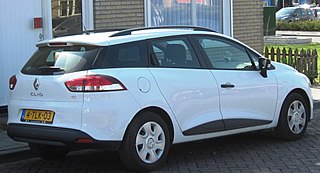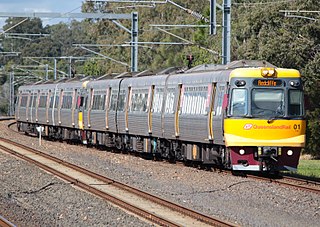
The International Space Station (ISS) is a space station, or a habitable artificial satellite, in low Earth orbit. Its first component was launched into orbit in 1998, with the first long-term residents arriving in November 2000. It has been inhabited continuously since that date. The last pressurised module was fitted in 2011, and an experimental inflatable space habitat was added in 2016. The station is expected to operate until 2030. Development and assembly of the station continues, with several new elements scheduled for launch in 2019. The ISS is the largest human-made body in low Earth orbit and can often be seen with the naked eye from Earth. The ISS consists of pressurised habitation modules, structural trusses, solar arrays, radiators, docking ports, experiment bays and robotic arms. ISS components have been launched by Russian Proton and Soyuz rockets and American Space Shuttles.

The PlayStation is a home video game console developed and marketed by Sony Computer Entertainment. The console was released on 3 December 1994 in Japan, 9 September 1995 in North America, 29 September 1995 in Europe, and 15 November 1995 in Australia. The console was the first of the PlayStation lineup of home video game consoles. It primarily competed with the Nintendo 64 and the Sega Saturn as part of the fifth generation of video game consoles.

The PlayStation 3 (PS3) is a home video game console developed by Sony Computer Entertainment. It is the successor to PlayStation 2, and is part of the PlayStation brand of consoles. It was first released on November 11, 2006, in Japan, November 17, 2006, in North America, and March 23, 2007, in Europe and Australia. The PlayStation 3 competed mainly against consoles such as Microsoft's Xbox 360 and Nintendo's Wii as part of the seventh generation of video game consoles.
A television network is a telecommunications network for distribution of television program content, whereby a central operation provides programming to many television stations or pay television providers. Until the mid-1980s, television programming in most countries of the world was dominated by a small number of terrestrial networks. Many early television networks evolved from earlier radio networks.

A filling station is a facility that sells fuel and engine lubricants for motor vehicles. The most common fuels sold in the 2010s are gasoline and diesel fuel. A filling station that sells only electric energy is also known as a charging station, while a typical filling station can also be known as a fuelling or gas station, gasoline stand or SS (Japan), petrol pump or petrol bunk (India), petrol garage, petrol station, service station, a services, or servo (Australia), or fuel station (Israel).

Mir was a space station that operated in low Earth orbit from 1986 to 2001, operated by the Soviet Union and later by Russia. Mir was the first modular space station and was assembled in orbit from 1986 to 1996. It had a greater mass than any previous spacecraft. At the time it was the largest artificial satellite in orbit, succeeded by the International Space Station (ISS) after Mir's orbit decayed. The station served as a microgravity research laboratory in which crews conducted experiments in biology, human biology, physics, astronomy, meteorology and spacecraft systems with a goal of developing technologies required for permanent occupation of space.

Paddington, also known as London Paddington, is a Central London railway terminus and London Underground station complex, located on Praed Street in the Paddington area. The site has been the London terminus of services provided by the Great Western Railway and its successors since 1838. Much of the main line station dates from 1854 and was designed by Isambard Kingdom Brunel.

A station wagon is a car body style which has a "two-box design": one for the engine, and the other a passenger area that includes a large cargo area and rear tailgate hinged to open from the back for access to the cargo area. The body style is similar to hatchback cars, however, station wagons are longer, and are more likely to have the roofline extended to the rear of the car to maximize the cargo space.

Pennsylvania Station, also known as New York Penn Station or Penn Station, is the main intercity railroad station in New York City and the busiest in the Western Hemisphere, serving more than 630,000 passengers per weekday as of 2018. Penn Station is in Midtown Manhattan, close to Herald Square, the Empire State Building, Koreatown, and Macy's Herald Square. Entirely underground, the station is located in Midtown South beneath Madison Square Garden, between Seventh and Eighth Avenues and between 31st and 33rd Streets, with additional exits to nearby streets.

WKRC-TV, virtual and VHF digital channel 12, is a CBS-affiliated television station licensed to Cincinnati, Ohio, United States. The station is owned by the Sinclair Broadcast Group, which also operates MyNetworkTV affiliate WSTR-TV through a local marketing agreement (LMA) with owner Deerfield Media. The two stations share studios on Highland Avenue in the Mount Auburn section of Cincinnati, where WKRC-TV's transmitter is also located.
In broadcasting and radio communications, a call sign is a unique designation for a transmitter station. In the United States of America, they are used for all FCC-licensed transmitters. A call sign can be formally assigned by a government agency, informally adopted by individuals or organizations, or even cryptographically encoded to disguise a station's identity.
A television station is a set of equipment managed by a business, organisation or other entity, such as an amateur television (ATV) operator, that transmits video content via radio waves directly from a transmitter on the earth's surface to a receiver on earth. Most often the term refers to a station which broadcasts structured content to an audience or it refers to the organization that operates the station. A terrestrial television transmission can occur via analog television signals or, more recently, via digital television signals. Television stations are differentiated from cable television or other video providers in that their content is broadcast via terrestrial radio waves. A group of television stations with common ownership or affiliation are known as a TV network and an individual station within the network is referred to as O&O or affiliate, respectively.

The Blue Line of the Delhi Metro system in Delhi consists of 44 metro stations from Dwarka Sector 21 to Noida City Centre with a length of 50.56 kilometres and a branch line consisting of 8 stations from Vaishali to Yamuna Bank, with a length of 6.25 kilometres.
PlayStation Network (PSN) is a digital media entertainment service provided by Sony Interactive Entertainment. Launched in November 2006, PSN was originally conceived for the PlayStation video game consoles, but soon extended to encompass smartphones, tablets, Blu-ray players and high-definition televisions. As of April 2016, over 110 million users have been documented, with 90 million of them active monthly as of November 2018.

PlayStation is a gaming brand that consists of four home video game consoles, as well as a media center, an online service, a line of controllers, two handhelds and a phone, as well as multiple magazines. It is created and owned by Sony Interactive Entertainment since December 3, 1994, with the launch of the original PlayStation in Japan.

The PlayStation 2 (PS2) is a home video game console that was developed by Sony Computer Entertainment. It is the successor to the original PlayStation console and is the second iteration in the PlayStation lineup of consoles. It was released in 2000 and competed with Sega's Dreamcast, Nintendo's GameCube and Microsoft's Xbox in the sixth generation of video game consoles.

A train station, railway station, railroad station, or depot is a railway facility or area where trains regularly stop to load or unload passengers or freight. It generally consists of at least one track-side platform and a station building (depot) providing such ancillary services as ticket sales and waiting rooms. If a station is on a single-track line, it often has a passing loop to facilitate traffic movements. The smallest stations are most often referred to as "stops" or, in some parts of the world, as "halts".

The PlayStation Vita is a handheld game console developed and released by Sony Computer Entertainment. It is the successor to the PlayStation Portable as part of the PlayStation brand of gaming devices. It was released in Japan on December 17, 2011, with releases in North America, Europe, and other worldwide regions starting on February 22, 2012. It primarily competes with the Nintendo 3DS as part of the eighth generation of video game consoles.

The PlayStation 4 (PS4) is an eighth-generation home video game console developed by Sony Interactive Entertainment. Announced as the successor to the PlayStation 3 in February, 2013, it was launched on November 15 in North America, November 29 in Europe, South America and Australia, and on February 22, 2014, in Japan. It competes with Microsoft's Xbox One and Nintendo's Wii U and Switch.

















